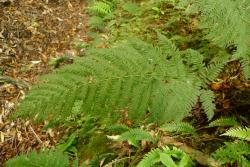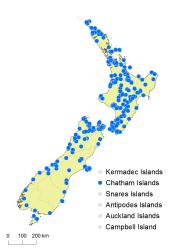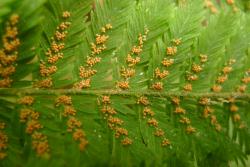- Taxon
- Gallery
- ≡ Todea hymenophylloides A.Rich., Essai Fl. Nouv.-Zél., 97, t. 16 (1832)
- ≡ Osmunda hymenophylloides (A.Rich.) J.B.Armstr., Trans. & Proc. New Zealand Inst. 13: 368 (1881)
- = Todea pellucida Carmich. ex Grev. & Hook., Bot. Misc. 3: 232 (1833)
- = Todea marginata Colenso, Trans. & Proc. New Zealand Inst. 29: 419 (1897)
- ≡ Leptopteris marginata (Colenso) C.Chr., Index Filic. 390 (1906)
Rhizomes erect, short or sometimes forming woody trunks up to 500 mm (rarely to 1000 mm) tall. Fronds 220–980 mm long. Stipes 110–480 mm long, pale brown, sparsely woolly hairy. Laminae 2-pinnate-pinnatifid, elliptic, ovate, or triangular, 140–725 mm long, 95–330 mm wide, green, membranous and translucent, sparsely hairy particularly on abaxial surfaces of costae of primary and secondary pinnae. Primary pinnae in 15–30 pairs, narrowly ovate to narrowly triangular, with acute apices, widely spaced along rachis; the longest at or below the middle of the rachis, 60–180 mm long, 25–55 mm wide; the basal pair 50–120 mm long. Secondary pinnae oblong or narrowly elliptic, 14–28 mm long, 5–10 mm wide, sessile or adnate, divided most of the way to the midrib. Ultimate lamina segments linear, attenuate, flattened in plane of frond. Sporangia scattered on abaxial surfaces, confined to proximal part of primary and secondary pinnae.
Leptopteris hymenophylloides has very thin, membranous fronds, resembling filmy ferns and can be confused with them when very young. It is distinguished from L. superba by its longer stipe, triangular lamina, longer and broader pinnae, and by its ultimate laminal segments, which are flattened in the plane of the frond. The basal pinnae (50–120 mm long) are significantly longer than those in L. superba (1–20 mm long) and this character alone will usually distinguish the two species.
North Island: Northland, Auckland, Volcanic Plateau, Gisborne, Taranaki, Southern North Island.
South Island: Western Nelson, Sounds-Nelson, Marlborough, Westland, Canterbury, Otago, Southland, Fiordland.
Chatham Islands, Stewart Island.
Altitudinal range: 10–950 m.
The species has a predominantly northern distribution. It is abundant in much of the North Island, especially in lowland and montane areas, from 10 to 950 m, but is uncommon in truly coastal regions, especially on the east coast and in Taranaki. In the South Island it is more common in lowland regions, but extends locally to 925 m in montane areas of inland Marlborough; it is absent from much of the high country.
A terrestrial fern that occurs in lowland to montane areas, under kauri, podocarp, broadleaved and beech forest, especially on damp banks and along streams, but also on drier valley sides and ridge tops. It frequently occurs with L. superba, but the latter is usually confined to damper sites and valley floors.
Leptopteris hymenophylloides and L. superba frequently occur together in wet, forested areas, and they hybridise readily. Hybrids (Leptopteris ×intermedia) show regular bivalent formation at meiosis and have spores of normal appearance, but there is no evidence for second-generation hybrids (Brownsey 1981).
n = 22 (Manton 1950; Brownlie 1958; Brownsey 1981).






